
After the inclusion, you will see in the list of libraries the new library created, to edit just click on the right side of the name in the “Edit” option. Select the level of inclusion, either Project or Public, and enter the name of the new library. To take advantage of this functionality, we must use the macro, sc_url_library () to import libraries into applications. PHP …) that can be used in your projects facilitating reuse of code. Now every time you call this function “changeColorButtonInsertForm ()” in the form, the include button will be stylized.Ĥ – External Library – This feature allows you to import complete libraries and create files of any extension (.JS. Then just insert your PHP routine, you can also insert other languages into the internal library, for example: CSS, HTML, JS… To add a new one just click on the “New” button after entering a name for the library and if you want to, add a brief description. Select the access level of the library you want. Public – All Scriptcase users have access to script. Project – All users linked to that project will have access to that script.

User – Only the user will have access to the script created. There are 3 levels of access: user, project and public. Okay, now you already have a data dictionary and you can create applications without worrying about the fields.ģ – Internal Library – Tool that allows the creation of php routines or upload files that can be reused in various project applications or other projects, depending on the level of access in which they are saved. Then just click the “back” button and if you’re done making changes click on “Update”. Now we can see that more definitions have appeared for the selected field (categoryname), we can still define if the field is mandatory, define a minimum and maximum number of characters, add a mask and a help message so the user understands what should be Inserted in that field. It’s possible to define some more information by clicking the Button “ x “, check it below: So you won’t waste any time adjusting the name of each field in the table. Whenever you use the “categories” table, the fields are given the name defined in the Data Library. By doing this, it’s not necessary to change the field’s label each time you use that table.


In the picture above, we can see that the fields were given different labels and sizes.

When you do this, all tables will be added to the Data Dictionary and you will be able to start creating your own definitions, as we can see below: When you use this feature it’s possible to create a data repository,and to associate it to one or more tables.ĭefine the label for the tables and click “Next”, then “Add”.
SCRIPTCASE HIDE BLOCK ON EDIT HOW TO
An example on how to use this option: click on the “General Data“ tab and set the number of paging records.īy doing so, whenever you create an application with paging, it will automatically load the paging defaults applied in “Default Values“.Įxplore the other tabs to define default settings for your projects before starting the development.Ģ- Data Dictionary – An important tool used to internationalize a project. Let’s take a look at some facilitators that can be used before and while creating a project.ġ – Default Values – With this option we will be able to standardize the creation of applications on our project, which results in productivity increasing. What most don’t know is that beyond doing this, it will make simple options available, which makes all the difference to us developers, and that’s what I’m going to show you guys on today’s post. We already know that Scriptcase is an excellent tool that promotes faster development of websites and systems. Check out some options within Scriptcase that will work tips as facilitators that developers can use before and while they are creating projects.


 0 kommentar(er)
0 kommentar(er)
